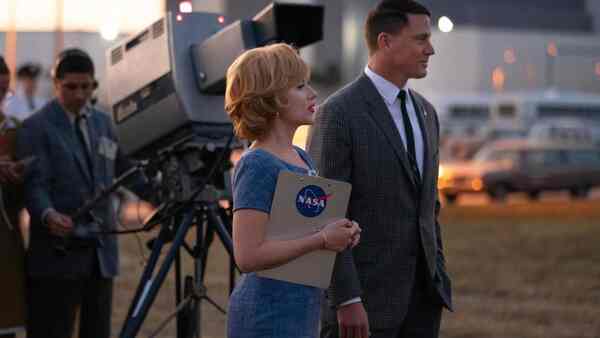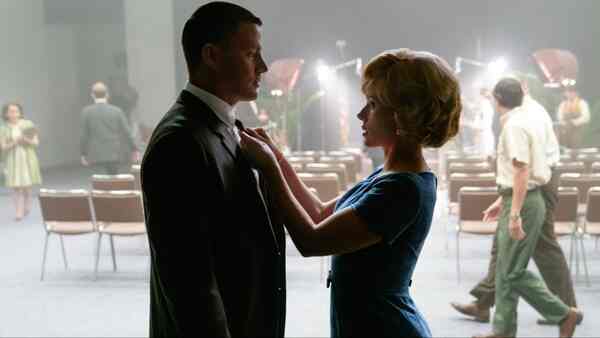Fly Me To The Moon Is A Surprisingly Enjoyable Tryst With The Stars
The film, by design, is a striking mix of art and advertising. The primary characters and their on-screen fashion add imaginary colour to the black-and-white canvas of history.

Promo poster for Fly Me To The Moon.
Last Updated: 10.07 PM, Jul 12, 2024
IT'S 1969. The United States of America are in a space race with the Soviet Union. Former President John F. Kennedy promised to put a man on the moon. The average citizen is not pleased with the billions being spent on this program. They’d rather the government address real issues – unemployment, a flagging economy, soldiers dying in the Vietnam War. But NASA needs this win. Not just to justify federal funding or repair their public image, but because they’ve already lost some of their own to this cause. The Apollo 11 mission must succeed – politically, personally and culturally. An achievement like this would distract people from a nation in strife, much like the movies do. Except it won’t be fiction…or will it?
America wants to reach for the stars because the question is simple: Should they gaze up at the sky or continue finding their feet? The moon mission will offer them an escape from earthly problems – and Earth itself. The image of the planet from afar is the literal manifestation of the ‘big picture’. Sometimes, a miracle is all it takes. Science is, after all, a bridge between dignity and divinity. The message from NASA is clear: Live, by all means, but not at the cost of dreaming.
Two paragraphs. Same premise. The first one is the truth. The second one is how the truth is sold. Fly Me To The Moon is a clever and entertaining film that situates itself between the two. It revolves around the budding romance – and sexual tension – between these clashing schools of thought. It’s about Cole Davis, the grumpy mission launch director with no time for non-science affairs. And it’s about Kelly Jones, an advertising expert hired to make the moon mission a household name. He wants to work quietly; her job is to make that work famous. He wants to expand the truth of mankind; her job is to sell that truth in the language of legal lies. He doesn’t like that she tells fibs for a living; she doesn’t care for his cold genius. Naturally, they learn to take a leaf out of each other’s book. He teaches her the old-school pleasures of being authentic; she teaches him the new-age pleasures of being cool. He takes man to the moon; she shows him the Earth he’s doing it for. Her idea to broadcast the moon landing to the world evokes Prince Charles’ efforts to modernise the monarchy in the early seasons of The Crown. In both cases, the presence of a humble camera is meant to humanise a distant and clinical institution.

The thing about this film is that, by design, it’s a striking mix of art and advertising. The primary characters are dressed like they’re in a corny cereal commercial. You can tell that they’re the imaginary colour on the black-and-white canvas of history. Channing Tatum’s vivid polo necks, in particular, give it away. Some of the tropes are straight out of the underdog handbook. Like, for instance, the introduction of Lucy as a superb liar – and as someone who has no qualms weaponising her gender in a man’s field. Or the introduction of Cole as a scientist driven by guilt and redemption. These are clean marketing motifs, where storytelling doubles up as a good-looking business.
Yet, the actual mission and outer-space sequences are impressively shot and edited. The visuals are gritty and poignant when they need to be. The con-job and tensions are Argo-like. It’s almost like the film manifests the personalities of Kelly and Cole through the way it looks and feels; one is pitted against the other. His truth and her lies are literally embodied by the ‘Project Artemis,’ a state-sponsored plan to film and stage a backup Moon landing in case things go south. This little film within the film is the masterstroke of Fly Me To The Moon; it playfully weaves the decades-old ‘hoax landing’ into its plot, daring the viewer to enjoy its audacity. It features a gay director who thinks he’s better than Kubrick, and a production set that more or less trolls the conspiracy theorists. The payoff is just as clever, especially because it seamlessly blurs the lines between reality and fiction.

Perhaps Kelly’s sad past – which the wily White House ghost (Woody Harrelson) uses to blackmail her – is surplus to proceedings. But there’s the added bonus of watching an advertising executive realise, for once, that not everything needs to be faked. Not every lie needs to be sold. The film visibly bats for Cole’s worldview, his unbelievable truth, as a way of implying that reaching the moon remains the hardest thing in the world. No amount of marketing or politics can distract from that. It’s only fitting that Kelly makes him accessible by making the moon plausible. If that isn’t a readymade romantic comedy, I don’t know what is. After all, publicising the success of our significant other is the simplest expression of love.

 Premium
Premium